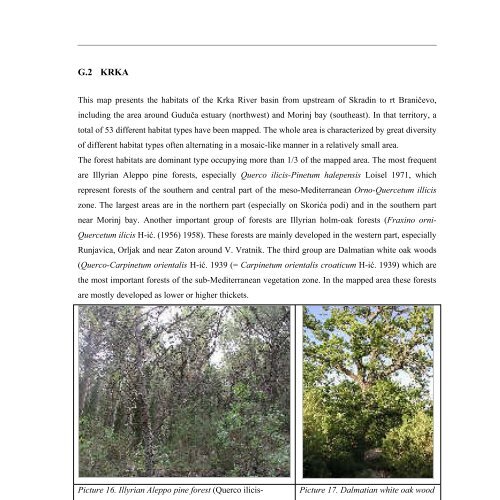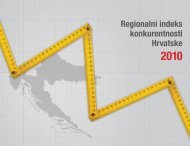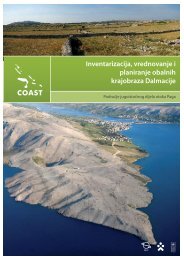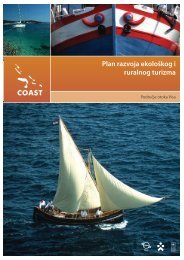PriruÄnik o kartama staniÅ¡ta Dalmacije - UNDP Croatia
PriruÄnik o kartama staniÅ¡ta Dalmacije - UNDP Croatia
PriruÄnik o kartama staniÅ¡ta Dalmacije - UNDP Croatia
- No tags were found...
Create successful ePaper yourself
Turn your PDF publications into a flip-book with our unique Google optimized e-Paper software.
G.2 KRKAThis map presents the habitats of the Krka River basin from upstream of Skradin to rt Branievo,including the area around Gudua estuary (northwest) and Morinj bay (southeast). In that territory, atotal of 53 different habitat types have been mapped. The whole area is characterized by great diversityof different habitat types often alternating in a mosaic-like manner in a relatively small area.The forest habitats are dominant type occupying more than 1/3 of the mapped area. The most frequentare Illyrian Aleppo pine forests, especially Querco ilicis-Pinetum halepensis Loisel 1971, whichrepresent forests of the southern and central part of the meso-Mediterranean Orno-Quercetum illiciszone. The largest areas are in the northern part (especially on Skoria podi) and in the southern partnear Morinj bay. Another important group of forests are Illyrian holm-oak forests (Fraxino orni-Quercetum ilicis H-i. (1956) 1958). These forests are mainly developed in the western part, especiallyRunjavica, Orljak and near Zaton around V. Vratnik. The third group are Dalmatian white oak woods(Querco-Carpinetum orientalis H-i. 1939 (= Carpinetum orientalis croaticum H-i. 1939) which arethe most important forests of the sub-Mediterranean vegetation zone. In the mapped area these forestsare mostly developed as lower or higher thickets.Picture 16. Illyrian Aleppo pine forest (Querco ilicis-Pinetum halepensis).Picture 17. Dalmatian white oak wood(Querco-Carpinetum orientalis).Other forest habitats occupy small areas only (Pistacio-Juniperetum phoeniceae Trinajsti 1987 andConifer plantations). Sometimes the respective area is even smaller than the minimal mapping unit,like in case of Ostryo-Quercetum pubescentis (Ht.) Trinajsti 1979 and Ostryo-Quercetum ilicisTrinajsti (1965) 1977, so such forests are not shown on the map.98

















